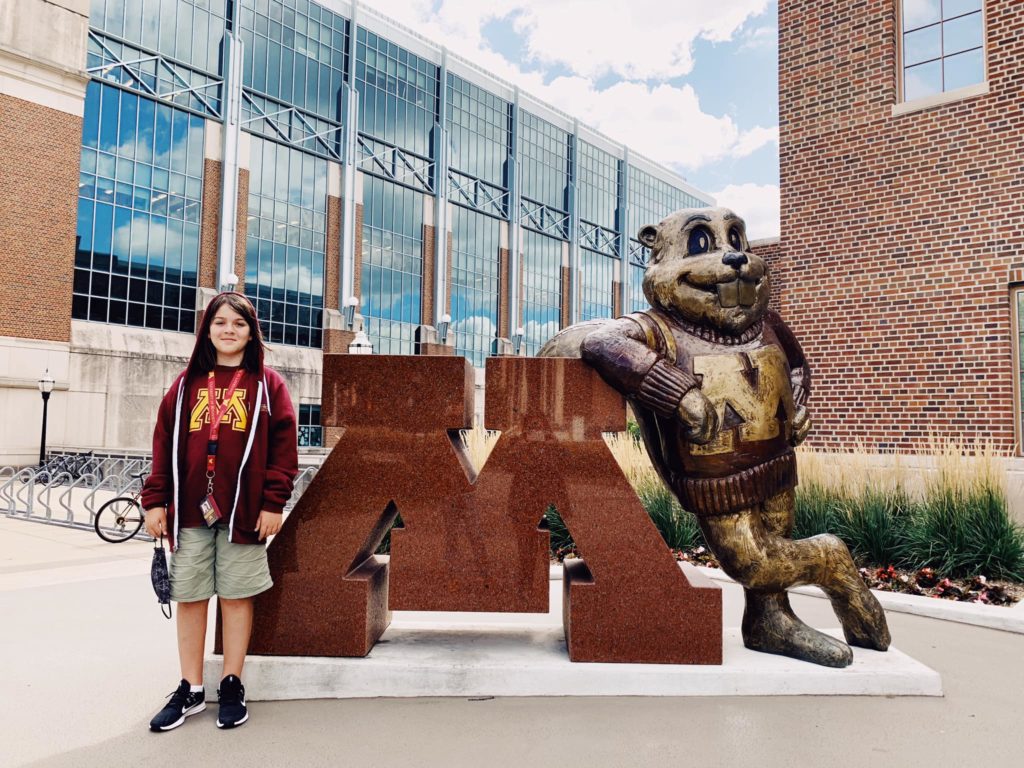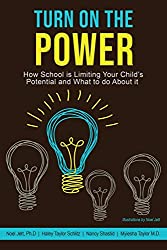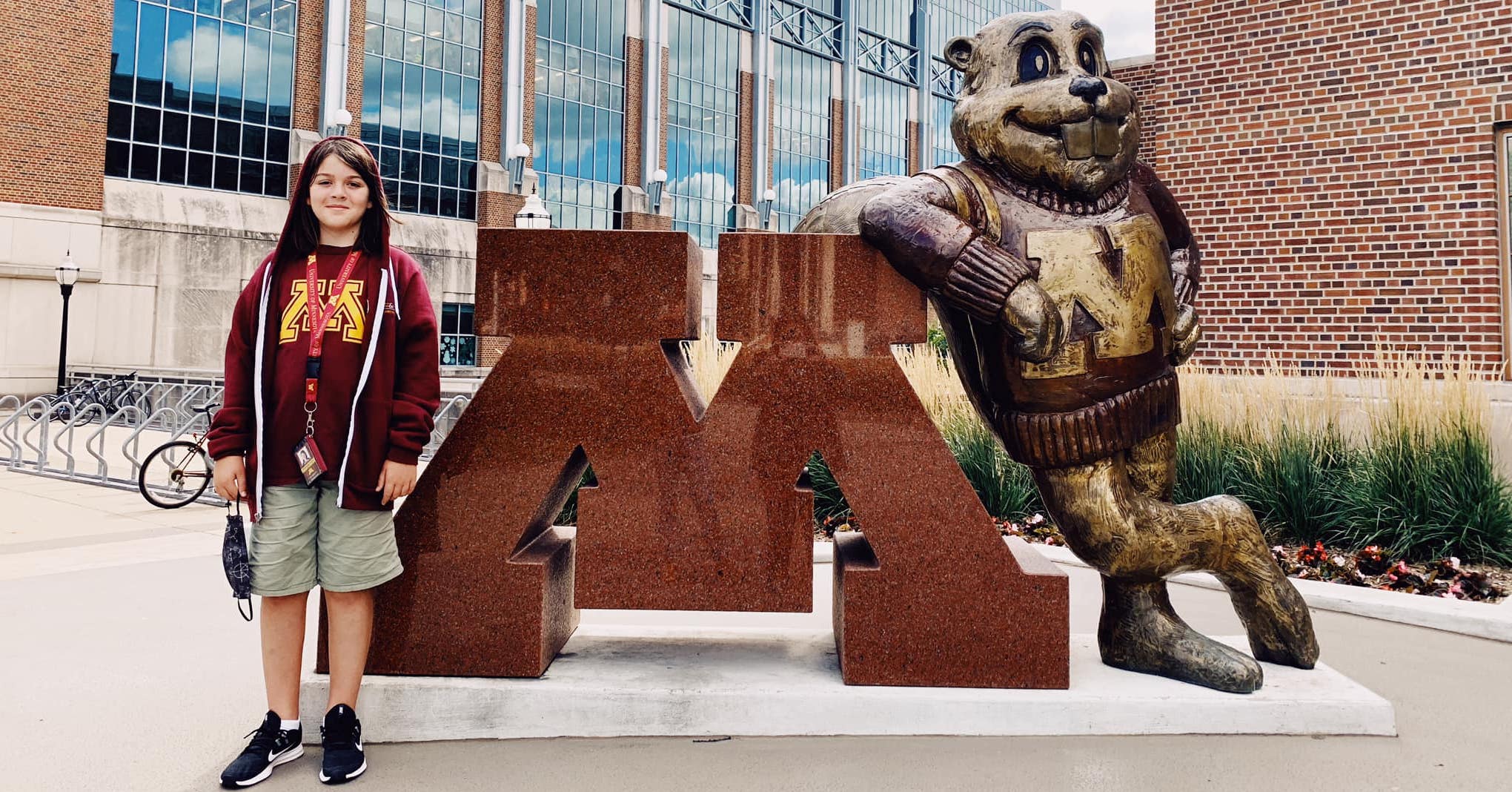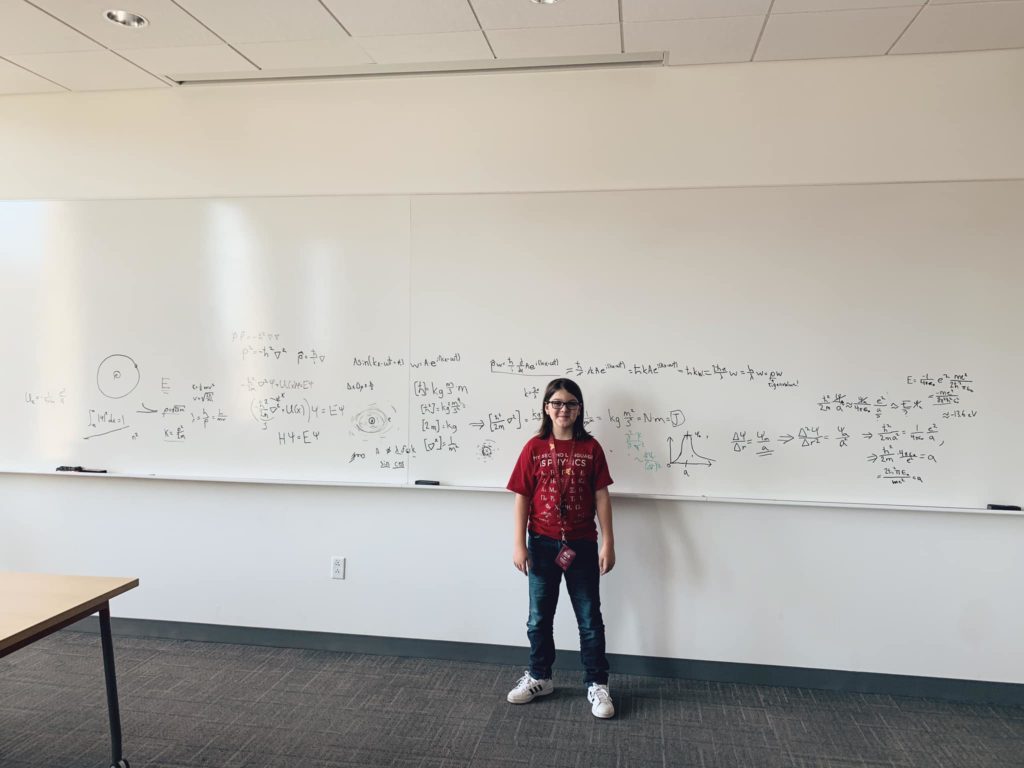Mainstream media is sharing stories of kids starting college early. Many parents wonder if this is a direction they can take with their gifted child. There is a lot to consider when deciding if this the right road to take. Early college is a highly personalized decision, weighing many factors above and beyond academics. There are many ways to obtain college-level learning and classes, even without being enrolled in community college or university for radically gifted learners.
Mainstream media is sharing stories of kids starting college early. Many parents wonder if this is a direction they can take with their gifted child. There is a lot to consider when deciding if this the right road to take. Early college is a highly personalized decision, weighing many factors above and beyond academics. There are many ways to obtain college-level learning and classes, even without being enrolled in community college or university for radically gifted learners.
Early College Student Statistics
The Center for Educational Statistics reports in 2017, 1.8% (1,233,155) of all full-time college students were 14-17 years old. (These statistics included 17-year-olds that did not grade skip but instead enrolled in college with age-similar peers, depending on their birthdays.)
It is not too uncommon for a 13-year-old to start taking college-level classes. It can be a great way to enrich students’ education, especially if they are thriving in a particular subject or two. It becomes less common if the student fully enrolls in a university at 13 and even more rare starting full time, on-campus college under 12 or younger. There were only 43 full-time postbaccalaureate students in the United States 14-17 years old in 2017.
Is Your Child Ready for Early College?
Deciding to enroll in early college isn’t an easy decision. There is a lot of thought that goes into this rather large decision. Being academically ready for college is only one piece of the puzzle.
For anyone pondering early college, you will also need to look at other considerations besides academic level. Parents may be unaware that there other aspects besides academics when enrolling in college which is essential for a successful experience in college, including their social-emotional development.
A fantastic resource for information regarding radical acceleration is The Acceleration Institute. They have a publication called A Nation Empowered that has valuable data on the types of acceleration. It is an excellent resource for parents of all gifted children, not just early college students. The Acceleration Institute also has a helpful tool called the Iowa Acceleration Scale. It is a beneficial tool for parents trying to decide if their child is ready for grade skipping. Have a conversation with your child to make sure this is something they would like to do.
The Davidson Institute offers parent and student guides for early college evaluations to assess if your student is college-ready, not only academically but “personally” as well. You can find the parent guide here and the student guide here:
Is Your Student Academically Ready for College?
Gifted students are often asynchronous in development, including what subject’s they may thrive in academically. A gifted student in math may run out of high school-level courses; you may be looking at college-level math classes a whole lot sooner than you expected. There are many great options to study certain subjects at a college level without enrolling in college. Some students will be synchronous in academic classes and find themselves completing high school in a fraction of the time either by grade skipping or curriculum compacting. There are ways to tailor the student’s education to fit their individual needs, ranging from a part-time online class to full-time on-campus enrollment and everything in between.
The most clean-cut way of knowing if your child is ready for college classes is that they have already completed high school level classes. The student should have exposure to high school-level content before college. It will speak of academic readiness and reduce the risk of gaps in education that can be more difficult to fill at the college pace and level. If the student is successful with the high school classes, consider having the student take the SAT or ACTs or the college placement test that your local community college offers. These tests are a good indicator if the student is college-ready, similarly to other age typical high students. It is possible for students under 13 to take the SAT or ACT. (To sign up a student under 13, refer to this prior blog post for more info.)
If your child was given a growth test in school, be aware of what assessment the student took. For example, depending on the student’s test, it may report the 2nd-grade child as of 12th-grade level in a test designed for 2nd-5th graders. Meaning, the score the 2nd grader received is the score a 12th grader would expect to receive on the same test, which is for 2nd-5th graders. It does not mean they have been exposed to or are ready for 12th-grade materials. If they have reached the ceiling of those tests, you may consider having the student taking a test with a high ceiling.
Comprehension, critical thinking, and writing skills will be necessary for college enrollment as well. Even in math and science classes, the student should legibly write and type assignments, reports, labs and communicate independently with their professors. Having completed high school English and composition classes is very beneficial for younger students enrolling in full-time college.
Non-Academic Considerations for College Enrollments
Executive functioning skills
Executive functioning skills are of the utmost importance when considering for-credit college classes. Expectations are younger students will conduct themselves efficiently with limited to no help from administration and professors. During a typical middle school and high school career, the student will most likely have time to develop these skills. However, students that start college early may not have developed the executive functioning skills needed at a college level yet. Evaluate your student for their weaknesses and work on these skills for a successful early college experience.
Executive functioning skills include time management, organization, task initiation, attention span, working memory, self-control, etc. A helpful book to read is “Smart But Scattered Teens,” which is for sale on Amazon.
Social skills
Having adequate social skills and maturity will be critical for the student to enroll in college. The college will assume the student will behave as any other age-typical college student. (IE raising their hands and listening to long lectures without disruptions). The student should be able to conduct themselves with maturity during group projects, labs, study groups, etc. They will also need to know how to advocate for themselves and have the confidence to do so. The student will be on their own as you, the parent, will not be talking to the professors on your child’s behalf due to FERPA regulations. College professors didn’t sign up to teach 10-year-olds in general, so some professors may not welcome a younger student in their classroom. You may consider speaking with the administration on approaching the professors of your child’s classes in college. Sometimes a conversation with the professor will be beneficial to the student and their situation. The administration may also know which professors are a good fit for your child and which ones you may want to avoid. The student should be going into the college environment self-sufficient. Sometimes, college administration and professors may worry about having to “babysit” the student.
Permanent Record
An important consideration is that college credits may stay on the student’s permanent college record. Be sure that the student is ready for high-level classes and the college environment. Credits and GPA may transfer to another institution, even years down the road. Bad grades may lower the overall GPA later in their college career. It may be helpful to consider other options before enrollment into college as a trial run by starting with an online community college class and working up to on-campus courses, and so on.
Considerations for Athletes
High school and college-level sports may disqualify students from participating depending on their accelerated declared grade or early enrollment in college. They may no longer be eligible to play sports with their age-level peers, so thoroughly investigate all the rules and requirements of their chosen sports.
Are You Sure Your Child is Ready?
Don’t ruin early college for the next student. Please be mindful of all the aspects of your child’s readiness. Suppose the college has taken a chance on your student and it did not go well. In that case, they may be less willing in the future to work with students that are ready for the college level and environment. It is a big responsibility so others can follow in your student’s footsteps!

College Level Learning & Credits Without Enrollment in College
There are many worthy options to obtain a college-level education without actually enrolling in college. These options are often free or low costs and allow a student to access higher-level learning.
MOOC classes
MOOC stands for Massive Open Online Courses. Some universities have classes available to anyone to enroll in, including ivy league schools such as MIT, Stanford, Harvard, Rice, etc. These classes are usually asynchronous for any potential student to take on their own time and at their own pace. Often, you can contact the instructor with questions. These classes are free to take, and you can pay to have a certificate issued, if you choose, at the end of the course. While these certificates do not count towards college credit, they can be beneficial for homeschool high school transcripts if your state requires proof of classes taken. It’s also an excellent way to see if your student is ready for college-level learning without potential disruptions on their college transcript. Common MOOC platforms include www.edX.org and www.coursera.org, but there are others as well.
AP/CLEP/DSST
Advanced Placement (AP), College Level Examination Program (CLEP), and DANTES Subject Standardized Test (DSST) are credit by examination ways to obtain college credit. The student may take a class, read a study guide, or take the test to receive credit for college before enrollment. It is essential to know that not all universities accept AP/CLEP/DSST for credits and if they do, they may limit the amount. It is university-dependent, and you should research each potential university your student will be interested in for transfer. The information is typically available on each university’s website.
Auditing College Classes
Some community colleges and universities will allow students to audit classes for free without receiving credit. You may either approach a college professor or the college administration to see if they will consider this. Some colleges have steadfast rules against auditing, while others are open to it. If a professor agrees to audit their class, permission will have to be granted by the administration. The student will attend class as a typically enrolled student without any college credit given. For the whole college experience, the student may perform homework and take the exams. Younger students will enjoy the content and ability to learn at the college. Auditing can also be a great way to evaluate if the student is ready for the college environment, pace, and content level. You may suggest the college test the waters by agreeing to let the student audit a class on a trial basis to enroll in courses in the future.
Earned Admission Opportunities
Arizona State University – Universal Learner (formally know as ASU Earned Admission) is a ubiquitous tool that under 18 students use for college-level classes (Even your 7-year-old!). This program allows anyone regardless of age to take any number of their 23 Universal Learner courses for $25.00. It is not the same as being enrolled as an ASU student. Suppose the student is happy with their final grade; they can pay $400 to receive the earned credit that may be transferable to other universities. However, some colleges will not accept the credit the student has earned for transfer. Utilize the www.transferology.com website to see if these classes will transfer to universities your child may consider or contact potential universities directly. If they don’t automatically transfer, you can request the university to review the course for transfer credit. (You will need the course syllabus to petition for transfer credit.) Completing a required number of courses through ASU UL with a 2.75 or higher GPA may make you eligible for degree-seeking enrollment at ASU.
ASU also has an in-person program called the Herberger Young Scholars Academy. They “work solely with highly gifted students, offering advanced and accelerated curriculum differentiated specifically for gifted learners so we can meet students where they are in their academic, social and emotional development and allow them to grow and develop at their own unique pace. From middle school content to advanced University courses and the opportunity to work individually with ASU professors in a mentorship, Herberger Young Scholars Academy creates pathways for highly gifted students to explore…”.
Another similar option is the Outlier program. The student can receive credit for classes for $400 through the University of Pittsburg. Outlier currently has six courses one can choose from online.
Western Kentucky University has a dual enrollment program (not associated with your state’s dual enrollment program). “Qualified” high school junior and senior level students can take classes for $174/credit (typically around $1142 per class). The student will need to have a high school level transcript already and a 2.5 GPA to enroll. The parent would declare the student as a junior or senior to enroll. Currently, there are 23 classes to choose from in the Online and Early College sections.
These types of “Earned Admission” programs are starting to become more popular, and I suspect more opportunities like this will become available in time.
“Non-Degree Seeking” Programs
Another option for early college is to enroll in a “non-degree” seeking program or community education program. Some universities will offer classes to “non-degree” seeking students. Institutions may limit how many courses the student can take or how many credits are allowable.
For example, Oregon State has such a program. You would apply to Oregon State as a non-degree seeking student, and these classes are $308 per credit.
When looking at non-degree-seeking university opportunities, make sure you inquire if those credits will be allowed to transfer into a degree-seeking enrollment.
Enrolled Early College Options
Dual Enrollment Programs
Many states offer some form of dual enrollment. These programs allow students to take college classes before high school graduation. Dual enrollment programs vary by state and may go by different names. Some may offer part-time or full-time college enrollment before graduation. For a brief listing of what each state offers, check out the States Website Education Commission or google your state + dual enrollment. Dual enrollment programs are funded partially or entirely by the state. Some programs include college enrollment in-person/online classes at the community college/university or “college in the classroom.” The high school will have a teacher or college professor teaching a college-level course for this option.
Some states allow children of younger grades to enroll. In contrast, other states require the student to be registered as a junior or senior in high school. A homeschooled student may be able to declare as a high school junior or senior to utilize the program (even if they are not the age of a typical junior or senior). A public school student would have to accelerate the young student to junior or senior status, which they might not be willing to do. Familiarize yourself with your state’s program and how you could use it for your student’s benefit of no-cost college enrollment, even considering special arrangements with the district and state for your under aged student.
Community College Enrollment
Public 2-year schools/community college is one of the most popular routes of early college for students under 18. Start by researching nearby community colleges and what their entry requirements are. Many community colleges do not require a high school diploma or high school transcripts to be accepted. Outside of a state’s dual enrollment program, attending community college would require out-of-pocket expenses. Financial aid may be an option you could utilize to cover college tuition if the student has officially graduated from high school, including radically accelerated students that have graduated early.
A common question is if you should have your homeschooled or radically accelerated student take the GED test. The general recommendation is no. A GED is not needed for college enrollment. As a homeschooler, a parent can issue a diploma when high school graduation requirements are met for your state’s homeschooling laws. The community college will not need a high school diploma. Universities will accept a transcript with high school-level classes. Many universities still do not look favorably at GEDs and it’s not needed.
Some community colleges may already have a procedure in place for younger students. With other young college students in recent news, it’s becoming less of a taboo idea that some students will be ready for college at a younger age. They may have already had a younger college student come through the system that has allowed them to figure out how to process and accommodate these students.
When advocating for enrollment into community college, start by contacting the president or the dean of of the school. Admissions administration tend to say no out the gate for younger students as they have guidelines they have to follow. By requesting a meeting with the president or dean, they can meet the student. You can provide documentation that can help advocate. Some things you may consider bringing with you are:
•PSAT/SAT/ACT scores
•Transcript of high school level courses taken
•Letters of recommendation of ability and maturity from outside sources (such as other teachers or co-op teachers)
•Portfollio of work that demonstrates late high school level content
You might consider bringing in news stories of other successful young college students to show that this can be a successful endeavor for the student and college. If the president or dean deems the student ready, they can help make special accommodations in admitting the student. The student will be required to take their placement test, such as the Accuplacer, for admission and class placement. This test will determine a student’s readiness for reading, writing, and mathematics courses.
When deciding on a community college, it’s crucial to utilize a website like www.transferology.com or similar to see if the student’s classes would be transferable to a 4-year university of interest. (Sometimes, this information is also available directly on the college of interest’s website.) In some cases, local community colleges will have aligned their standards with the state university. Most of those classes and credits already have approval for transfer to the university. It’s essential to constantly analyze potential universities when deciding what courses to take in community college so that the student won’t have to take additional classes in the university.
It may be possible to receive an Associate of Arts or Associate of Sciences degree before attending the university, even before (or concurrently) receiving a high school diploma. The student often will still be considered a 1st-year college student at the university. It’s best to double-check with potential universities if obtaining a 2-year degree before graduation affects their coming status as a freshman or transfer student. It may have an impact on financial aid and scholarships as well.
Some colleges may have an age requirement which can be a hurdle. The Office for Civil Rights (OCR) enforces the Age Discrimination Act of 1975. The act “prohibits discrimination based on age in programs or activities that receive federal financial assistance, in schools and colleges that receive federal funds from the U.S. Department of Education.”. It is handy to know this information when advocating for your young student. However, there has not been a court case tried concerning early college. A letter from an attorney discussing the ADA of 1975 has helped advocate for some parents. It’s important to note that the student must meet the admission requirements as any other potential student. If your child does not meet all admission requirements, it is likely they will not be permitted to attend regardless of the ADA of 1975.
When a young student attends on-campus classes, the college may have concerns about the student’s safety. It is one of the most reported reasons higher learning institutions have not allowed younger students to enroll. Be prepared that often a parent must be on campus with the student during their classes, especially if the student is younger than 13. Sometimes this means in the classroom with the very young student, waiting outside the door, or somewhere else readily assessable on campus. You may be required to accompany the student from classroom to classroom and be reachable by phone in emergencies. To further the college’s comfort level, you may also suggest that you have an attorney write a hold harmless agreement.
Early College Entrance Programs
Some universities have early college programs such as Bard at Simons Rock, Mary Baldwin University Early College, and CalState Early Entrance Program. These programs are both commuter and residential opportunities and allow students to take college classes with other academically advanced, age-similar peers. Students as young as 11 can enroll in some of these early entrance programs.
Here are some early college programs:
- Bard at Simons Rock
- Mary Baldwin University Early College
- PEG at Mary Baldwin University
- CalState Early Entrance
- Clarkson School
- Kansas Academy of Math and Science
- Texas Academy of Math and Science
- University of Alaska Early Honors
- Bucksbaum Early Entrance Academy
- University of Washington Academy
- University of Washington Early Entrance
- Boston University Academy
- Davidson Academy
https://profoundlygiftedparenting.com/early-college-programs/
Full-Time 4 Year University Enrollment
Outside of enrolling in a 4-year university as a dual-enrolled student or early college program, some young students may be ready to attend a 4-year institution full-time as degree-seeking students. You will rely on financial aid, scholarships, and grants to minimize out-of-pocket tuition and expenses.
When starting the 4-year university application process, you will also be completing the FASFA (financial aid) form as required by the university. If the student is under 13, you will have to print out a PDF copy and apply by mail. Even if you don’t need or won’t qualify for financial aid, it is necessary to fill out the FASFA form for possible scholarship requirements, including merit scholarships.
Some universities have their applications process on their website, and others only allow applications through the CommonApp. Due to internet privacy laws, students under 13 have to go through a cumbersome process setting up an account.
Starting with community college is an excellent stepping-stone to being admitted to a 4-year university as a degree-seeking student. If the student has been successful in community college, they have established a positive track record of college readiness. It is also helpful in making a high school transcript that most universities require. The student may receive both high school and college credits for their community college classes before graduation and will be able to use those classes on a high school transcript. That is especially helpful for the homeschooled student. (Do note that there are a few universities that do not require a high school diploma, although most do.) It’s best to research potential universities (usually listed on their websites) to see their requirements for admittance.
Suppose the student has taken community college classes or has even earned an A.S. degree. In that case, they may still be eligible for freshmen status, allowing for more scholarship opportunities. Sometimes a university may look at the student as a transfer student. There are transfer scholarships available as well.
Generally, when applying to a 4-year college, the student will have to meet the application requirements, the same as any other applicant. The student may need to have a high school transcript and diploma, SAT/ACT scores, and essays. (All colleges have different requirements, so check with the college your student is interested in for specific requirements.)
It’s necessary for homeschoolers and radically accelerated students to maintain a transcript of high school courses. You can include high school classes, dual enrollment/early college courses, awards, volunteering, or any clubs and sports they have participated in on the transcript. You can make a transcript on a spreadsheet or use a transcript service such as www.transcriptmaker.com. Each university will have listed their requirements from high school graduates, so cross-reference your student’s transcripts with what the university requires.
While some schools are doing away with SAT/ACT requirements, many schools still require these scores for admittance. If your student is under 13 and needs to sign up for testing, refer to this prior blog post on how to sign up for these tests.
Before your student submits their application, it is advisable to reach out to the university, especially if your student is under 17. When you can work as a team with the university, they may be more able to accommodate the student to develop an enrollment plan. They may also put together an advising team to help your student during their college career. It can help establish a graduation plan and enroll in courses with professors sensitive to this unique situation.
Like community college, young university students may be required to have parents or guardians on campus, especially for students under 13.
Good luck on your early college journey! Advocating and arranging early college options for your student takes time, dedication, and a lot of hard work but it’s so rewarding.
If you have any questions, reach out to me!
RESOURCES
https://pre-ap.collegeboard.org/pdf/pre-ap-account-creation-form-students-under-13.pdf
https://nces.ed.gov/programs/digest/d19/tables/dt19_303.40.asp?current=yes
ARTICLES
Thinking Through Early Entrance to College
https://www.davidsongifted.org/search-database/entry/a10096
Minors on Campus: Underage Students at CA Community Colleges
https://files.eric.ed.gov/fulltext/ED510570.pdf
BOOKS



OTHER
Digest of Education Statistics, 2019. (n.d.). Retrieved March 24, 2021, from https://nces.ed.gov/programs/digest/d19/tables/dt19_303.40.asp



